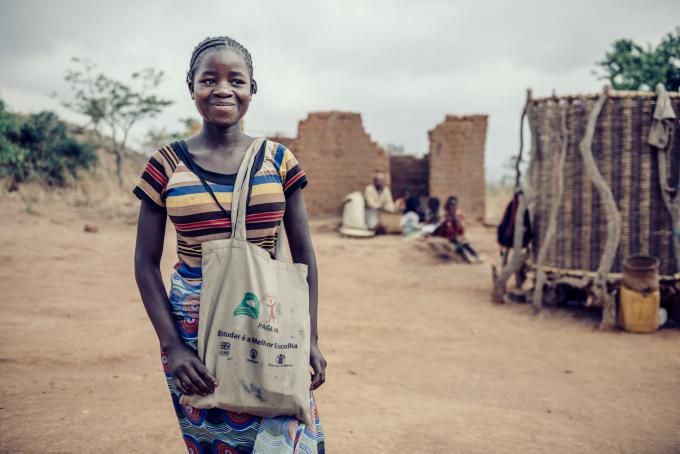Campaign My School, My Future
CAMPAIN ‘MY SCHOOL, MY FUTURE’
- Promote girls education in the remote areas of Mozambique.

Rapariga beneficiária de bolsa de estudo do projecto de educação de rapariga.Foto: Save the Children/2015.
Analysis of your context, including which of the most excluded children your campaign will focus on.
The situation of children has improved in Mozambique over the last decade but more work still needs to be done to ensure more children are surviving, learning and are protected. The work that remains includes the urgency to review or amend public policies and legislative frameworks that inadvertently promote exclusion of children and more specifically girls. This also necessitates the need to change community’s attitudes, culture and practices that inhibit realization of desired policy objectives. This is especially important given that whereas Mozambique has embraced the Universal Free Primary Education, net enrolment rate is only 60% and the transition rates for girls depict a downward trend that signal the unique challenges that girls face in Mozambique including but not limited to child marriage and household poverty.
Analysis of your problem and solution, -please focus your analysis on the barriers preventing survival and learning in the group of most deprived and most marginalised you have decided to focus on for your campaign.
Every Last Child (ELC) Campaign in Mozambique will leverage the Promoting Advancement of Girls Education in Mozambique (PAGE-M) –now STAR-G (Successful Transition and Right for Girls project) that target girls who are at risk of dropping out, have dropped out, or have never enrolled in schools with interventions to support successful transitions from lower to upper primary, and upper primary to lower secondary. The ELC will focus on two broad areas to address the evident exclusion of girls from learning: a. advocating for review/amendment of public policies/legislative framework that tolerate/promote exclusion of girls and; b. promoting positive changes in community knowledge, attitudes and practices that inhibit girls’ education.
With regard to the former, the Campaign will push for amendments to the marriage laws that at present permits marriage of girls below the age of 18 with parental consent. This gaping legal weakness partly explains the widespread child marriage practice in Mozambique where nearly 50% of the girls get married before the age of 18. Since dropout rates for girls due to pregnancy is a major problem, the ELC will focus on influencing changes to the government decree that requires pregnant girls to attend the evening/night classes. This is not only insensitive but also complicates learning for expectant girls. This is especially the case in the rural areas where power is not only limited but also unreliable. The Campaign will call for the lifting/amendment of the decree to allow expectant girls to attend classes that best suit their circumstances. Besides, the Campaign will also advocate for effective implementation of the Gender Strategy/Code of Conduct for teachers that sexually exploit and/or impregnate girls given the predominance of cases where male teachers are responsible for pregnancies in schools. Lastly, the Campaign will seek to influence investment in education infrastructure to enhance access to girls’ education by not only reducing the physical distances to schools but also ensuring that boarding facilities for girls are well secured and are safe. Insecurity in such facilities account for the low completion rate of 42% for girls.
With regard to the latter, the Campaign is alive to the interconnectedness of economic, social, and cultural factors that form critical barriers to girls’ education[1] and collectively contribute to high dropout rates in Mozambique. Povertyis widespread, with the extreme poor accounting for 54% of the population (MMAS). Hence we estimate that at least this proportion of girls (54%) in our target schools are marginalised through the effects of poverty, with many made extremely vulnerable through multiple factors including food insecurity, health threats from poor water supply, harmful traditional practices or HIV/AIDS. Families commonly cite financial difficulties as the main reason why children are not in school[2]. Other demand side barriers preventing girls’ access are social norms such as girls working (also an opportunity cost), limited aspirations for girls beyond (early) marriage and pregnancy.
The goal of the Campaign is to contribute toward elimination of barriers that prevent girl’s education especially in remote areas in Mozambique by 2019.
This goal is directly linked to the priority campaign objective on the education breakthrough and addresses girls as the most marginalized and vulnerable in Mozambique. The advocacy campaign will focus on the policy and legislation frameworks that inadvertently enable girls’ exclusion as well as focus on addressing the discriminatory social and cultural factors.
The objectives of the Campaign are:
- Advocate for increased national budget allocation to the education sector and especially, construction of safe and secure boarding facilities for girls.
- Advocate for a review of the government decree that only allows expectant girls to attend evening/night classes
- Influence amendment to legislation that legalizes marriage of girls below 18 years to align it with the UNCRC
- To address the social and cultural barriers to girls’ education
[1]UNESCO Institute for Statistics (2011). “EdStats 2011.” Paris: UNESCO.
[2] United Nations Development Programme (2011). “Sustainability and Equity: A Better Future for All (Human Development Report 2011).” New York: UNDP.
 Mozambique
Mozambique